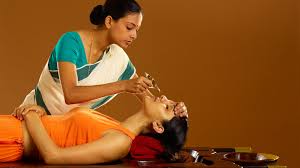 The word Ayurveda is from Sanskrit, an ancient Indian language. It literally means “Knowledge of life”. The underlying concept in the practice of Ayurveda principles is that you are capable of taking charge of your own life and healing. Simply put, this concept offers a philosophy where individuals are able to prevent unnecessary suffering and live a long and healthy life.
The word Ayurveda is from Sanskrit, an ancient Indian language. It literally means “Knowledge of life”. The underlying concept in the practice of Ayurveda principles is that you are capable of taking charge of your own life and healing. Simply put, this concept offers a philosophy where individuals are able to prevent unnecessary suffering and live a long and healthy life.
Ayurveda is also known as the mother of all medical systems. It has undergone research, development and refinement by practitioners over the past 5000 years, originating in India. Currently undergoing a world wide revival as individuals are seeking more and more alternative medical approaches to prevention and treatment, Ayurveda employs the application of nutritional counseling, herbal medications, exercise, meditation and other therapies. It is a total patient oriented system rather than the traditional Western Medicine disease oriented system.
Interestingly, many of the scientifically supported health prevention that is currently recommended has been practiced by Ayurveda practitioners for centuries. They believe that individuals should rise with the sun, followed by meditation and exercise. Exercise is done in the morning before bathing and the intensity is dependent upon the body type. Ideally individuals should exercise at ½ their capacity with the preferred method being yoga.
After exercise the individual will cleanse their tongue, using a special instrument to freshen the mouth and stimulate the digestive enzymes. Prior to bathing Sesame Oil is massaged into the nostril to keep the passages moist. A hot bath will then relieve fatigue, clean the body and improves the appetite.
Practitioners also recommend specific diet plans for different diseases and constitutions while recommending people completely stay away from alcohol, tobacco or other recreational drugs.
The Ayurveda practitioner believes that there are three distinct body types, all of which have their own strengths and challenges. The Vata is usually thin, coarse curly hair, head and eyes are small, and have trouble gaining weight. The Pitta will have medium build, height and bone structure. They will have soft skin that is warm to the touch that will bald or gray early. They like sweet, bitter foods such as candy, green salad and bananas. They may be assertive and aggressive, highly organized and intelligent. They tend to be teachers, doctors and lawyers.
The Kapha’s are large boned people who are not tall but are the foundation of their society. They have a tendency toward being overweight. Hair is thick and wavy. They have small appetites and eat slowly – but are big snackers. They aren’t very active people and prefer repetitious jobs. They are compassionate, forgiving and loving, often becoming social workers, nurses and clergy.
It is important to remember that not one person will be just one body type but rather a combination of the three. In Ayurveda, once the body type is understood then a diet, constructed to meet your individual needs, can be determined.
Practitioners also believe that there are three different tastes that should be enjoyed in the diet – sweet, sour, salty, pungent (onion), bitter, and astringent (apples). Herbs and spices are incorporated into the cooking and diet to improve overall health and well being as well as make the food more palatable – without an over use of salt. Antioxidants are mixed into the diet to prevent disease, which are based on inflammation, such as cancer, diabetes and stroke.
In 2004, The National Center for Health Statistics and The National Center for Complementary and Alternative Medicine released the results of a survey in the United States. 4/10 of 1% of all people who responded (31,000) had used Ayurveda in the past. While this number is not huge (slightly over 150 people) it is growing.
 When an individual first goes to see a practitioner the initial assessment can last up to an hour. An in-depth history is taken about your health, diet and lifestyle. Unlike traditional Western medicine, practitioners will approach a physical examination in a different manner. For instance, 12 different pulse points are assessed rather than the three standard ones during an initial evaluation with the Western medical practitioner.
When an individual first goes to see a practitioner the initial assessment can last up to an hour. An in-depth history is taken about your health, diet and lifestyle. Unlike traditional Western medicine, practitioners will approach a physical examination in a different manner. For instance, 12 different pulse points are assessed rather than the three standard ones during an initial evaluation with the Western medical practitioner.
The Ayurveda practitioner will also examine the tongue because they believe it provides clues about areas of the body that may be out of balance. The appearance of the skin, lips, nails and eyes will also be observed, looking for organ systems or areas of the body which are believed to be out of balance.
After this in-depth history and assessment the practitioner will discuss the individual’s unique balance of body types and make recommendations regarding their diet and any potentially unhealthy habits which they may be practicing. From there the practitioner will create an individualized treatment plan that will include diet, exercise, herbs, yoga, meditation and massage. All of these treatments are aimed at restoring balance to the specific body type which the individual possesses.
When used for preventative medicine these practices fall well within the range of traditional Western medicine. However, any indication that these practices or treatment recommendations can cure major illnesses or medical conditions have not yet been proven through empirical clinical study. For this reason medical practitioners may welcome the treatment recommendations of an Ayurvedic practitioner as adjective therapy but will not find enough clinical proof that these treatment plans will cause a cure in most of the major illnesses which plague us today.
Resources:
The Ayurvedic Institute
http://www.ayurveda.com/
The Chopra Center: Ayurveda
http://www.chopra.com/ayurveda
National Center for Complementary and Alternative Medicine: Ayurvedic Medicine
http://nccam.nih.gov/health/ayurveda
University of Maryland medical Center: Ayurveda
http://www.umm.edu/altmed/articles/ayurveda-000348.htm
Yoga Journal: Ayurveda and Yoga
http://www.yogajournal.com/health/ayurveda
National Center for Complementary and Alternative Medicine: Ayurvedic Medicine
http://nccam.nih.gov/health/ayurveda/introduction.htm
Chopra Centered Lifestyle: What is Ayurveda
http://www.chopra.com/ccl/what-is-ayurveda/#
University of Connecticut Health Center: About Ayurveda
http://casc.uchc.edu/ayurveda/


Leave a Reply